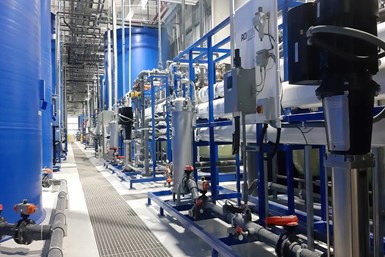
IntelliKON platform.Photo Credit: Kontek
The COVID-19 pandemic has impacted all areas of our lives. Many businesses have been forced to implement new ways of working to keep projects on track. Kontek Ecology Systems Inc. (Burlington, Ontario, Canada), provider of wastewater processing technology, found itself facing an unprecedented challenge in the midst of travel restrictions that required the company to adapt its approach.
Kontek was in the final stages of one of three large projects for a global leader in the aerospace industry. The project centered around one of the world’s most advanced surface finishing lines at a new extrusion, machining and finishing location in South-East Asia.
As a technology partner, Kontek was present for the ground-breaking, pre-installation inspection, installation kick-off and subsequent oversight visits. All was proceeding to plan, when the coronavirus situation made it impossible for the company to be physically present for the completion of installation, start-up and commissioning. To add to the pressure, a NADCAP audit date was already set.
The aerospace client’s new facility included a highly customized Kontek system to handle their process water purification, wastewater and recovery requirements. The client’s state-of-the-art facility required the most advanced level of automation available, so Kontek equipped their REKON, ROKON and 1400 systems with instrumentation and integration capabilities to support its new IntelliKON platform — the latest innovation from the Kontek family, building on the foundation of Kontek’s SMART LOGIC controls. According to the company, the IntelliKON package includes data acquisition, storage, and interpretation software to allow for advanced analytics on all types of Kontek systems. Optional enhanced controls enable technicians to remotely troubleshoot and service the equipment.
Although the IntelliKON was still in its alpha testing phase at the time, Kontek was able to expedite and “go live” with the beta testing of the platform. The IntelliKON package was enhanced with video conferencing and webcams to visually assist the commissioning process, from initial inspections, to IO checks, to discharging clean water. The solution enabled Kontek to remotely commission and monitor the entire project in order to meet the client’s tight schedule.
Related Content
-
NASF/AESF Foundation Research Project #121: Development of a Sustainability Metrics System and a Technical Solution Method for Sustainable Metal Finishing - 15th Quarterly Report
This NASF-AESF Foundation research project report covers the twelfth quarter of project work (October-December 2023) at Wayne State University in Detroit. In this period, our main effort focused on the development of a set of Digital Twins (DTs) using the Physics-Informed Neural Network (PINN) technology with application on parts rinsing simulation.
-
NASF/AESF Foundation Research Project #122: Electrochemical Approaches to Treatment of PFAS in Plating Wastewater - 7th Quarterly Report
The NASF-AESF Foundation Research Board has selected a project on addressing the problem of PFAS and related chemicals in plating wastewater streams, studying PFAS destruction via electrooxidation and electrocoagulation. Our last report described the results from experiments of EO with a Magnéli phase Ti4O7 anode on the degradation of eight perfluoroalkyl acids (PFAAs). In this seven quarter report, we describe work to further explore how the degradation of different PFAAs are related to their molecular structures.
-
NASF/AESF Foundation Research Project #122: Electrochemical Approaches to Treatment of PFAS in Plating Wastewater - 12th Quarterly Report
This NASF-AESF Foundation research project report covers the 12th quarter of project work (October – December 2023) at the University of Georgia. In our previous report, we described our work on performance and effect of surface fluorinated Ti4O7 anodes on PFAS degradation in reactive electrochemical membrane (REM) mode. This quarter, our experiments involved utilizing porous Ti4O7 plates serving both as anodes and membranes. Tests compared pristine and F-18.6 Ti4O7 anodes at current densities of 10 mA/cm2 and 40 mA/cm2. This 12th quarterly report discusses the mechanisms of the effects on EO performance by anode surface fluorination.













.jpg;maxWidth=300;quality=90)



